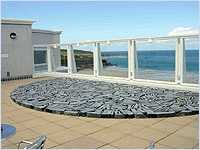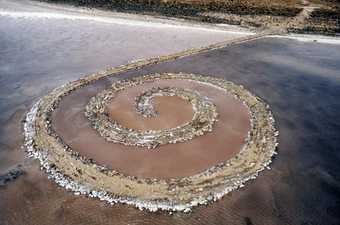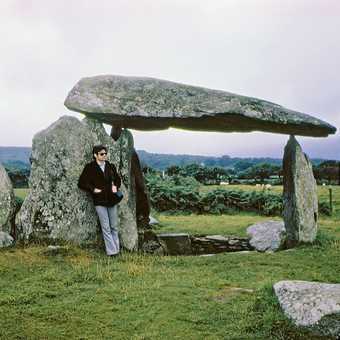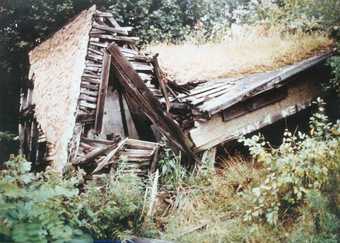Chinese artist Cai Guo-Qiang is perhaps best known for his orchestration of spectacular events and installations using materials as varied as paper lanterns, porcelain and, most famously, gunpowder and fireworks. In a seminal project executed shortly after his arrival in the United States in 1995, Cai ‘activated’ a series of historically and culturally charged landscapes – from Manhattan, New York to the Great Salt Lake in Utah (the site of Robert Smithson’s Spiral Jetty 1970) – by detonating small, hand-held explosive devices that formed miniature mushroom clouds. These clouds were documented in photographs which were first exhibited in 1996 as picture postcards and have subsequently been exhibited and published in a variety of formats (fig.1).

Fig.1
Cai Guo-Qiang
The Century with Mushroom Clouds: Project for the Twentieth Century (Manhattan) 1996
Realised in New York City, looking towards Manhattan, 20 April 1996
Gunpowder and cardboard tube
Photograph by Hiro Ihara
Courtesy Cai Studio
© Cai Guo-Qiang
With a performative gesture and a radical shift in scale, Cai imprinted perhaps the ultimate symbol of mankind’s destructive power onto highly charged sites. Describing his preparation for a visit to the Nevada nuclear test site (which was active between 1951–93), Cai suggested just how sensitive the undertaking was:
Before entering the site, I stayed at a hotel in Las Vegas, and dismantled a fire cracker purchased from Chinatown in New York. I put the black powder from the fire cracker inside a small paper tube leftover from fax paper. The paper tube is chopped in half, and stuck with a square piece of cardboard to the bottom; a fuse sticks out from a small hole in the middle of the tube. Now that I think back, this preparation work in the Las Vegas hotel is very similar to that of a terrorist.
In the morning, we met up in the lobby of the hotel. We were surrounded by the clatter of slot machines. The military staff from the test site came to escort us by car to the base, and along the way there were many security checkpoints. Towards the end of our visit, I snuck out a paper tube pre-loaded with black powder out of the blue, and made a small mushroom cloud that lasted a few seconds. The military person accompanying us was astounded, and called his supervisors immediately on his phone. The call was then transferred level by level to Washington D.C. His supervisors asked us to stay put on the spot. Not long after, an army jeep came towards us at high speed, and our gunpowder was inspected.
When the military staff saw the gunpowder hidden in a small plastic film canister, and discovered that it was only black powder from fire crackers, they smiled, and confiscated the canister. Since the Nevada Test Site was a place for atomic bomb research, my gunpowder by comparison was child’s play. After the military staff left, we quickly made a few more mushroom clouds with the unused gunpowder.1
The Century with Mushroom Clouds is a key project within Cai’s oeuvre. It offers a strategy for engagement that is both open and contradictory. Does it celebrate or condemn man’s capacity for destruction? Does it suggest a congruency between site and image? Does it constitute a cathartic gesture? Like many of the artist’s projects it brings together seemingly irreconcilable forces: destruction and creativity, calamity and renewal. And like many of his projects it engages with a complex matrix of historical, cultural and geographical themes. It can be understood as developing earlier concerns – for example, his explosion project The Earth Has Its Black Hole Too, created in Hiroshima in 1994 – and as a precursor to aspects of his subsequent practice, including controversial explosion events such as his ‘memorial’ for New York, Clear Sky Black Cloud 2006, and his project to create a black mushroom cloud in the sky above the peace memorial in Hiroshima in 2008. These are all examples of what the artist calls ‘fighting fire with fire’, using the tools of destruction to create resonant and potentially affirmative actions. Importantly, it connects the time he spent in Japan, where he lived in the mid-1980s, and the US, where he now resides. The work bridges these two geographies by addressing one of the most momentous events of the twentieth century – the dropping of atomic bombs on the Japanese cities of Hiroshima and Nagasaki by the American armed forces – and does so by recreating, and photographically representing miniature versions of the bombings in landscapes that symbolise the creative power of the United States.
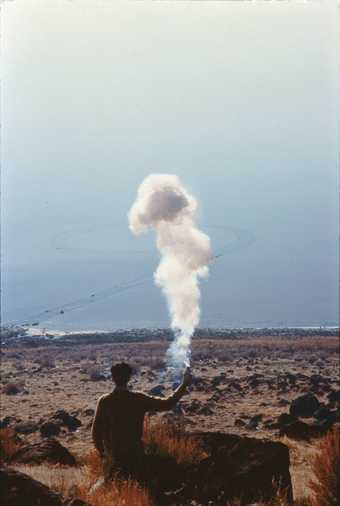
Fig.2
Cai Guo-Qiang
The Century with Mushroom Clouds: Project for the Twentieth Century (Salt Lake) 1996
Realised at Robert Smithson’s Spiral Jetty 1970, Great Salt Lake, Utah, 15 February 1996
Gunpowder and cardboard tube
Photograph by Hiro Ihara
Courtesy Cai Studio
© Cai Guo-Qiang
The project was originally conceived to be global, featuring similar actions in all of the nations that have nuclear capability, offering the cathartic ‘gift’ of a mushroom cloud at an important landmark in each country. However, after arriving in the US the artist felt the need to address what he has called the ‘American century’ and abandoned the global context.2
I felt that the mushroom cloud was one of the most important symbols of the twentieth century. After the destruction of Hiroshima and Nagasaki, military use of nuclear technology continued in the form of a ‘deterrent’ or threat. In a sense the mushroom cloud became increasingly conceptual, rather than real, as time went on. It becomes like the Great Wall of China because, practically speaking, the Wall doesn’t really keep the enemy out. Once you climb the wall, no matter how long it is, you’ve gotten across. But strategically and politically it’s extremely important to have this thing there. Displaying power, imposing power, is extremely important.3
The Century with Mushroom Clouds displays and imposes an icon of power, mediated by photographs that offer an important degree of ambiguity as to what we are looking at. It would be difficult to mistake the small smoke formations for actual atomic explosions, but not, on first glance, impossible. The particular role that these photographs play in the project is indicated by Cai’s decision to initially present it as a series of picture postcards. The writer Susan Sontag’s consideration of the uses of photography is pertinent here. She writes:
As photographs give people an imaginary possession of a past that is unreal, they also help people to take possession of space in which they are insecure. Thus photography develops in tandem with one of the most characteristic of modern activities: tourism.4
Cai conducted field research at a number of locations, including Manhattan, the former nuclear test site in Nevada, the Great Salt Lake (to visit Spiral Jetty; fig.2), and the Mormon Mesa near Overton, the site of Michael Heizer’s Double Negative 1969–70 (fig.3). The focus of his research was to inspect these sites – in particular the nuclear test site – as potential ‘tourist spots’, as well as for their potential as sites of confrontation (with tragic history) and, hopefully, healing. For Cai, the irony and power of the nuclear bomb lies in its duality. It led to the worst tragedies in human history yet its ‘monumental and beautiful’ images, he felt, overshadowed the most spectacular artworks of the twentieth century, including the ‘eroding’ land works not far from the Nevada site.5 The idea of nuclear tourism, however, is not so new. Cai has said, ‘When frequent testing took place at the Nevada Test Site, hotels in Las Vegas would advertise that guests staying with them could view mushroom clouds from their rooms’.
He then went on to draw a connection with the American land art movement of the 1960s:
Around the same time, Land Art emerged. I don’t think the contemporaneous timing of these two things is a coincidence. At the Nevada Test Site, there are over thousands of craters from nuclear testing, and some of these craters are over 100m deep. There are identical houses spaced one kilometer apart, and after each bomb is detonated, the degree of damage on each house would be examined. The site also has a railway, a highway overpass, and metal vaults like the ones in banks for testing the degree of destructiveness. All these artifacts with no purpose or use became remnants that witnessed the destructiveness of the atomic bomb. These structures are also artificial objects inserted into nature, and can be contemplated as and compared to artistic creation.
Since Cai’s first investigations of this bizarre potential, a touristic subculture has emerged, sometimes labeled as ‘atomic tourism’ (a sub-genre, perhaps, of what has been called ‘disaster tourism’).6 The Nevada Test Site is open to the public four times a year, and other locations, such as the Trinity Site, where the first atomic bomb was tested on 16 July 1945, are promoted by websites such as The Bureau of Atomic Tourism.7 Cai’s photographs, if not his actions, explicitly address this notion of nuclear tourism by consciously drawing on the tradition of the picture postcard. Although they undeniably resemble souvenir photographs, like the pictures taken in front of famous landmarks that record ‘being there’, there is one crucial difference: Cai does not look at the camera but at the landscape, and the viewer in turn looks with him, past him, at the site of history.
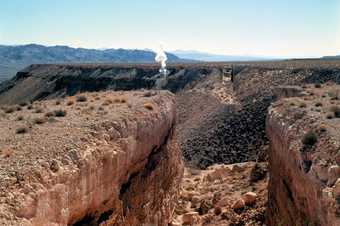
Fig.3
Cai Guo-Qiang
The Century with Mushroom Clouds: Project for the Twentieth Century (Mormon Mesa) 1996
Realised at Michael Heizer’s Double Negative 1969–70, Mormon Mesa, Overton, Nevada, 14 February 1996
Gunpowder and cardboard tube
Photograph by Hiro Ihara
Courtesy Cai Studio
© Cai Guo-Qiang
The language of tourism was harnessed in the first presentation of the work as an installation called Crab House at 80 Lafayette in Manhattan, which was part of the exhibition In the Ruins of the Twentieth Century, organised by PS1 in 1996. Here the images were shown as postcards on sales racks, available to buy for $1 each. Visitors were able to leaf through books containing images of nuclear explosions, and drink healing mushroom tea. There were also packs of cards in which lingzhi mushrooms were ‘prescribed’ in order to ‘detoxicate’ the curse of fourteen ‘beautiful’ nuclear images used in the same pack and ‘activate immunity of our imaginations’.8 Since this first presentation the images have been published in various books, and have floated free of this original, very determined context. As a result, they are more often read as documents of conceptual art, as the connection with the postcard or snapshot has become less clear with time. However, this raises a number of interesting questions pertaining not only to conceptual art but also to land art, and in particular to the relationship between a private performance or event in a specific location and its public representation in photographic form. What and where is the work? Is it the action performed in a specific place, or is it the image exhibited in the gallery, or reproduced in books and magazines? Or, indeed, is it a complex matrix in which these are all indivisible elements? Robert Smithson’s exploration of this territory led him to think of the dialectic of site and nonsite, while Richard Long declared that objects from a landscape exhibited in the gallery stimulate the senses, and that photographs or texts stimulate the imagination.9 Cai has responded to this debate by saying that the relationship between an action and its documentation is as between Buddha and an image of Buddha.10
In the photographs Cai’s modest, ephemeral actions (reduced to a single instant) contrast with the quasi-permanent, monumental scale of the earthworks and the space-age grandeur of the Manhattan skyline. All of the locations, from the expanses of the West to Manhattan, are quintessentially American, as are the works of land art chosen by Cai to feature in this project. Indeed, land art – as manifested in the US in the late 1960s and early 1970s – was a very self-consciously American idiom. The artist Alan Sonfist, for example, made the extraordinary assertion in 1983 that, ‘Art in the land is an American movement’.11 Of the canonical works of land art, the best known, and most analysed and revered, is undoubtedly Smithson’s Spiral Jetty. This alone would have made it a priority destination for Cai, but he undoubtedly would have also been drawn to Smithson’s symbolic evocation of entropy, of site and nonsite, and to the earthwork’s associations with industrial degradation. A number of writers have addressed the connections between Cai and Smithson,12 but it is Michael Heizer who plays a more pertinent role in relation to The Century with Mushroom Clouds for he absolutely embraced the nuclear age. Not only did Heizer pointedly proclaim the H-bomb to be ‘the ultimate sculpture’ but he reportedly also boasted to his patron Robert Scull that his massive earthwork, Complex One 1972, could withstand a nuclear attack.13 Heizer self-consciously set out to create ‘American’ artworks, considered as such because of their enormous scale: ‘It was a question of an American sensibility, things were being done that felt uniquely American – a lot of them had to do with size, size and measurement.’14 In 1985 he said: ‘My idea was to make American art … As long as you’re going to make a sculpture, why not make one that competes with a 747, or the Empire State Building, or the Golden Gate Bridge?’15 In the event, Double Negative required the excavation and bulldozing of 240,000 tons of rock and earth. The two cuts and the void that lies between them across the break in the Mesa Edge would apparently accommodate the Empire State Building lying on its side. Yet at the same time Heizer distanced himself from the poetics and history of the West and the symbolic dimensions that such a context might bring to his work. He has always emphasised practicality and formalism as his primary considerations: ‘It had nothing to do with landscape or the romanticism of the West. I was looking for material. The West isn’t romantic to me, I’m from there.’16 Or again, ‘I didn’t come here for the context. I came here for materials, for gravel and sand and water, which you need to make concrete, and because the land was cheap’.17
Nonetheless, Heizer has worked in a charged space. His principle site – where he continues to work on the monumental complex City – is in the same landscape as the nuclear test site in Nevada. In contrast to Heizer, Smithson selected his site and developed the Spiral Jetty in direct response to location and history, in particular to a local legend that the salt lake is connected to the sea by a series of underground channels that produce a whirlpool in its depths.
Cai’s project brings all of this background within its compass – it is there, haunting the work, so to speak – even though he, like Heizer, has spoken in terms of practical considerations. When asked why he selected these two specific sites and not, for example, Walter De Maria’s Lightning Field 1977 or Nancy Holt’s Sun Tunnels 1976, the other iconic works of American land art, he suggested that he was guided by proximity to the Nevada Test Site, which was the primary focus for his research. However, his purpose was also served by the degree of intervention these works exert upon their landscape settings. An equation of equivalence between creation and destruction is perhaps being suggested by Cai’s mushroom clouds and these earthworks.
Finally, how are we to think about these two ‘art sites’ in relation to the other locations in the series, the Nevada nuclear test site and Manhattan? The latter are undoubtedly the archetypal loci of capitalism, of consumerist excess, but this is perhaps a void distinction, for are they not all, in fact, landscapes of excessive consumption? An earthwork, especially on such a large scale, just as an atomic explosion – in purely economic terms – can be read as an unsurpassable symbol of excess.18
Having addressed the form of the work and the landscapes it uses, it is important to ask how a work of art activates the historical residue, the historical meaning, latent in a landscape. More specifically, how does The Century with Mushroom Clouds do this and for what purpose? Bringing together several parallel histories, Cai’s project is an attempt to effect a reconciliation between place and history, time and space, creativity and destruction. To do this he uses the idiom of the picture postcard or family snapshot as an agent of memory, a record or document but also – bringing an emotional dimension to bear – a ‘souvenir’, a memorial. In addition, these photographs are a factual record of actual events but they carry enough ambiguity to evoke or suggest a fiction, false memories of an event that never happened, a nuclear attack on Manhattan, for example, or the Great Salt Lake. We see a mushroom cloud and it elicits a particular set of visual memories and associations. We see the place or the site and it, too, evokes a set of memories or ideas. Taken together they represent a construction, a false memory. Of relevance here is Cai’s notion of the artist as a creator of what he evocatively calls ‘time/space tunnels’.19 These images function in this way. In them Cai initiates a series of powerful interconnections across geography and history, between Japan in 1945, Nevada during the post-war years, Nevada and Utah in the late 1960s and early 1970s, and Manhattan at the end of twentieth century, and by extension to the here and now.

